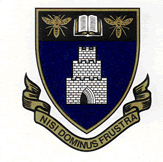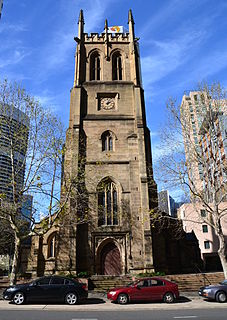
Launceston is a city in the north of Tasmania, Australia, at the junction of the North Esk and South Esk rivers where they become the Tamar River (kanamaluka). With a population of 87,328, Launceston is the second most populous city in Tasmania after the state capital, Hobart, and the fifth-largest inland city in Australia.

The Whitechapel Bell Foundry was a business in the London Borough of Tower Hamlets. At the time of the closure of its Whitechapel premises, it was the oldest manufacturing company in Great Britain. The bell foundry primarily made church bells and their fittings and accessories, although it also provided single tolling bells, carillon bells and handbells. The foundry was notable for being the original manufacturer of the Liberty Bell, a famous symbol of American independence, and for re-casting Big Ben, which rings from the north clock tower at the Houses of Parliament in London.

Longford is a town in the northern midlands of Tasmania, Australia. It lies 145 m above sea level at the convergence of the Macquarie River and the South Esk River, 21 km south of Launceston and a 15-minute drive from the airport. It is just south of the Illawarra Road, a road connecting the Bass and Midland Highways. It has a population of 3,863 and is part of the Northern Midlands Council area. The region is predominantly agricultural, noted for wool, dairy produce and stock breeding.

St Paul's Cathedral is an Anglican cathedral in Melbourne, Australia. It is the cathedral church of the Diocese of Melbourne and the seat of the Archbishop of Melbourne, who is also the metropolitan archbishop of the Province of Victoria and, since 28 June 2014, the present seat of the Primate of Australia.

The Cathedral Church and Minor Basilica of the Immaculate Mother of God, Help of Christians is the cathedral church of the Roman Catholic Archdiocese of Sydney and the seat of the Archbishop of Sydney, currently Anthony Fisher OP. It should not be confused with the nearby, later, Anglican St Andrew's Cathedral. It is dedicated to the "Immaculate Mother of God, Help of Christians", Patroness of Australia and holds the title and dignity of a minor basilica, bestowed upon it by Pope Pius XI on 4 August 1932.

St James' Church, commonly known as St James', King Street, is an Australian heritage-listed Anglican parish church located at 173 King Street, in the Sydney central business district of the City of Sydney local government area of New South Wales. Consecrated in February 1824 and named in honour of St James the Great, it became a parish church in 1835. Designed in the style of a Georgian town church by the transported convict architect Francis Greenway during the governorship of Lachlan Macquarie, St James' is part of the historical precinct of Macquarie Street which includes other early colonial era buildings such as the World Heritage listed Hyde Park Barracks.

Launceston Church Grammar School is an Anglican co-educational private school in Launceston, Tasmania, Australia for Early Learning through to Grade 12.

St John the Baptist Church is an Australian Anglican church in the Canberra suburb of Reid in the Australian Capital Territory. The church is located at the corner of Anzac Parade and Constitution Avenue, adjacent to the Parliamentary Triangle, and is the oldest surviving public building within Canberra's inner city and the oldest church in the Australian Capital Territory. It has been described as a "sanctuary in the city", remaining a small English village-style church even as Australia's capital grew around it. Over time, it became a focal point for Australia's governors-general, politicians, public servants and military leaders, and has hosted royalty on numerous occasions.

Carrick is a small historic village 17 kilometres (11 mi) west of Launceston, Tasmania, Australia, on the banks of the Liffey River. The Meander Valley Highway passes through the town's centre; this road was formerly the main road from Launceston to Deloraine and Devonport. Carrick has a well-preserved 19th-century heritage; fifteen of its colonial buildings are listed on the Tasmanian Heritage Register including Carrick House (1840), St Andrew's Church (1848), the Old Watch house (1837), Monds Roller Mill (1846) and the Carrick Hotel (1833).

St John's Cathedral is the cathedral of the Anglican Diocese of Brisbane and the metropolitan cathedral of the ecclesiastical province of Queensland, Australia. It is dedicated to St John the Evangelist. The cathedral is situated in Ann Street in the Brisbane central business district, and is the successor to an earlier pro-cathedral, which occupied part of the contemporary Queens Gardens on William Street, from 1854 to 1904. The cathedral is the second-oldest Anglican church in Brisbane, predated only by the extant All Saints church on Wickham Terrace (1862). It is also the only existing building with a stone vaulted ceiling in the southern hemisphere. The cathedral is listed on the Queensland Heritage Register.
Australian non-residential architectural styles are a set of Australian architectural styles that apply to buildings used for purposes other than residence and have been around only since the first colonial government buildings of early European settlement of Australia in 1788.

All Saints Anglican Church is a heritage-listed church at 32 Wickham Terrace, Spring Hill, City of Brisbane, Queensland, Australia. First founded in 1862, the current building designed by Benjamin Backhouse was completed in 1869, making it the oldest Anglican church in Brisbane. For most of its history, it has been identified with the High Church or Anglo-Catholic tradition within Anglicanism. It was added to the Queensland Heritage Register on 21 October 1992.
James Blackburn was an English civil engineer, surveyor and architect best known for his work in Australia, where he had been transported as a sentence for forgery. According to the Australian Dictionary of Biography, Blackburn "has claims to be considered one of the greatest engineers of his period in Australia, and his architectural achievements established him as Tasmania's most advanced and original architect." He was key to the formation of the Department of Public Works in 1839, serving as one of its core members under Alexander Cheyne.

The St Philip's Church, Sydney is the oldest Anglican church parish in Australia. The church is located in the Sydney city centre between York Street, Clarence and Jamison Streets on a location known as Church Hill. St Philip's is part of the Diocese of Sydney, Australia. The church is listed on the Register of the National Estate.

St John's Cathedral is a heritage-listed, Anglican cathedral in Parramatta, City of Parramatta, Sydney, New South Wales, Australia. St John's was given the status of provisional cathedral of the Anglican Diocese of Sydney in 1969, and designated a Regional Cathedral in 2011 for the Western Region. It was added to the New South Wales State Heritage Register on 5 March 2010.

St Mary's Anglican Church, often called now St Mary's-on-the-Cliffs, is a heritage-listed churchyard at 433, 447 & 449 Main Street, Kangaroo Point, Queensland, Australia. It was designed by Richard George Suter and built in 1873 by Alfred Grant. It was added to the Queensland Heritage Register on 21 October 1992. Kangaroo Point Cliffs Park was constructed to the church's south in 2010 and a gateway allows park users to visit the church's grounds.

St John the Baptist Anglican Church is a heritage-listed church at 171 Oxford Street, Bulimba, Brisbane, Queensland, Australia. It was designed by John Hingeston Buckeridge and built in 1888 by T Whitty. It was added to the Queensland Heritage Register on 9 July 2003.

Prince's Square is a park in Launceston, Tasmania, Australia. Established in 1858 from a disused brickfield it is now an important part of cultural life in Launceston and also a heritage park. The park is known for its symmetrical planning and the bronze gilded Val d'Osne Fountain. The park is bound on all four sides by Elizabeth Street, St John Street, Frederick Street and Charles Street.

St Andrew's Kirk, Launceston, is a Presbyterian church in Launceston, Australia serving the Presbytery of Bass. It was the second Presbyterian church to be built in the city of Launceston following the Scotch National Church on Charles Street. St Andrew's is located on St John Street between Patterson Street and Civic Square.

Launceston Post Office is a heritage-listed post office at 68-72 Cameron Street, Launceston, Tasmania, Australia. It was designed by William Waters Eldridge, with alterations prior to opening designed by Corrie and North. It opened in 1891, while the clock tower was completed in 1903 and altered in 1910. It was added to the Australian Commonwealth Heritage List on 22 June 2004.



















